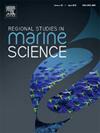Assessing pollution and ecological risks of potentially toxic elements in surface sediments of the north-central Persian Gulf
IF 2.1
4区 环境科学与生态学
Q3 ECOLOGY
引用次数: 0
Abstract
This study investigates pollution levels and ecological risks of potentially toxic elements (PTEs) in surface sediments of the North-Central Persian Gulf, a region heavily influenced by industrial activities. Sediment samples were systematically collected from 109 stations at depths ranging from 0 to 78 m. Analysis revealed a predominance of silt and clay (∼70 % of total composition). Concentrations of 14 major and trace elements followed the order: Ca > Al > Fe > Sr > Mn > Ba > Cr > Ni > V > Zn > Cu > Pb > As > Cd. The modified degree of contamination (mCd) indicated generally low contamination, though elevated pollution levels were detected near Bushehr Port, the Bushehr Nuclear Power Plant, and Khark Island, likely due to anthropogenic inputs. Significant enrichment of As and Cd was observed, alongside moderate enrichment of Cr and Ni, while Cu, Fe, Mn, Pb, V, and Zn exhibited minimal enrichment. Ecological risk assessment suggested low overall risk, with localized moderate risks at certain stations. Notably, Cd contributed 56 % of the total ecological risk, highlighting concerns near industrial zones. Geochemical analysis revealed that Al, Ni, Zn, Cr, V, Fe, and Cu primarily originated from terrestrial sources, reflecting regional geological background. Moderate enrichment of Ni and Cr aligns with naturally high soil concentrations in southern Iran. In contrast, elevated As and Cd levels point to significant anthropogenic influence, particularly near industrial sites, with Cd linked to oil tanker operations and industrial wastewater discharge. These findings underscore the urgent need for mitigation strategies such as (1) stricter controls on industrial and shipping-related discharges, (2) remediation of Cd and As hotspots near high-risk zones (e.g., Bushehr Port and Khark Island), and (3) long-term monitoring of benthic ecosystems to assess bioaccumulation risks.
求助全文
约1分钟内获得全文
求助全文
来源期刊

Regional Studies in Marine Science
Agricultural and Biological Sciences-Ecology, Evolution, Behavior and Systematics
CiteScore
3.90
自引率
4.80%
发文量
336
审稿时长
69 days
期刊介绍:
REGIONAL STUDIES IN MARINE SCIENCE will publish scientifically sound papers on regional aspects of maritime and marine resources in estuaries, coastal zones, continental shelf, the seas and oceans.
 求助内容:
求助内容: 应助结果提醒方式:
应助结果提醒方式:


